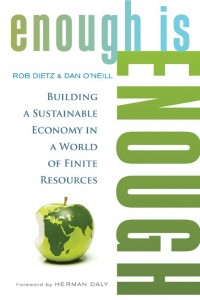Have You Had Enough? A Plan for a Sustainable Economy
Jan 18th, 2013 | By admin | Category: Economics and GDP
By Suzanne York, www.howmany.org
[H]ere’s the deal: forget that this task of planet-saving is not possible in the time required. Don’t be put off by people who know what is not possible. Do what needs to be done, and check to see if it was impossible only after you are done. ~Paul Hawken
This quote by Paul Hawken epitomizes the ideas and initiatives reflected in the new book Enough is Enough: Building a Sustainable Economy in a World of Finite Resources, which lays out a path for overcoming so-called impossibilities in our world. The book constructs a realistic and actionable plan that should guide all of us as we confront increasingly dire and critical issues facing the planet. There will always be naysayers yelling out “impossible!”, but clearly we are way past listening to them.
The basic question that Enough is Enough asks is how we can transition from a global economic system dependent upon unsustainable and endless growth to a steady-state economy. According to authors Rob Dietz and Dan O’Neill, the purpose of the book is to show “how to establish a prosperous yet nongrowing economy.”
A steady-state economy is defined as an economy which “aims for stable or mildly fluctuating levels in population and consumption of energy and material.” Even Adam Smith realized there were limits to economic growth. He predicted that eventually natural resources would become more scarce, population growth would depress wages, and division of labor would approach the limits of its effectiveness.
For some people, a steady-state economy is a radical idea. For others, it makes perfect sense in a world of finite resources with gross inequalities and a lot people stuck in the daily grind and not so happy, despite the latest got-to-have-it technology.
Enough is Enough actually builds the groundwork for moving towards a society that lives within its means and focuses on the things people want – happiness, well-being, economic security, food security, good health, clean environment, strong communities, and so on. Perhaps most importantly, it does so in an straightforward and reader-friendly manner.
The book suggest an actual blueprint of policies that could create a sustainable economy. Proposed solutions include: establishing more worker-owned companies, prohibiting banks from issuing money as debt (essentially preventing banks from creating money “out of thin air”), local currencies, and work-time reduction (to help reduce unemployment and improve citizen well-being).
Dietz and O’Neill believe the following policy directions would serve as pillars of a steady-state economy:
- Limit the use of materials and energy to sustainable levels;
- Stabilize population through compassionate and non-coercive means;
- Achieve a fair distribution of income and wealth;
- Reform monetary and financial systems for stability;
- Change the way we measure progress;
- Secure meaningful jobs and full employment;
- Reconfigure the way businesses create value.
Enough is Enough also positively and pro-actively deals with the often taboo subject of population growth. Just as with the economy, a steady population is needed in a world of finite resources. Most importantly, Dietz and O’Neill recognize that “hidden in population numbers are real people”, something that often gets lost in the discussion of a world of 7 billion people, and likely to grow to between 8 to 10 billion by 2050. Unless compassionate, non-coercive policies are devised, any population policy will ultimately not work. Successful policies include actions such as educating girls, empowering women, and providing family planning services.
The two authors bravely wade into the immigration debate, also a tumultuous issue. They are in favor of honoring current U.S. immigration policy of accepting refugees and reuniting families. As for admitting workers with specific skills to fill jobs (also U.S policy), they suggest that the U.S and other wealthy countries are tapping the best educated and skilled foreign workers, which results in a “brain drain” for the developing countries from which these workers mainly come. Developed countries want top talent to spur more economic growth. Yet in doing so, the wealthy (and high-consuming) countries increase population growth to the detriment of less wealthy nations.
It’s a sensitive subject, yet if you look past the emotional arguments around immigration, as the authors do, you’ll see that their position is one where, in their words, “Instead of recruiting educated and entrepreneurial people from abroad, wealthy nations should cultivate talent at home and encourage nations abroad to retain their most capable workers.” In a sense, it’s localizing the workforce, for the good of societies in both developed and developing countries.
The world is facing many critical issues, yet for the most part stubbornly continues with business as usual, to the detriment of society and the planet. Enough is Enough effectively tackles issues too many people want to ignore. Moreover, it not only provides fodder for lively discussions, but practical ideas for achieving a sustainable economy and healthy communities.
Suzanne York is a senior writer with the Institute for Population Studies

